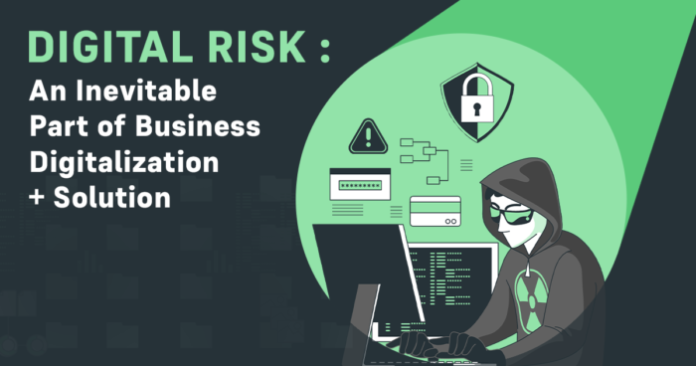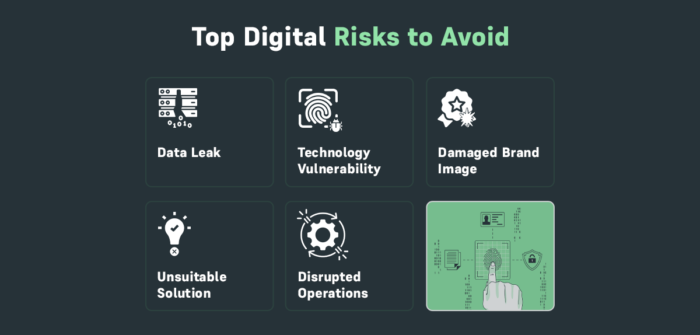Digital transformation is the latest business trend, with more and more businesses taking their operations online than ever before. Today, businesses rely on technology in numerous aspects, from selling their goods and services online to digitally managing operations and staff.
Owing to the increasing demand and scope of business technology, the IT sector is witnessing tremendous demand for its products and is becoming an integral part of numerous industries. However, you must know that digitalization comes with its own risks and threats, and there is a lot that can potentially go wrong.
In this blog, we will understand what exactly these digital risks are and how businesses can avoid them. However, let’s start with the basics, i.e., the scope and potential of business technology that is compelling businesses to shift from conventional to digital approaches.
Traditional to Digital Transformation: A Business Trend
The past years have witnessed a tremendous surge in digitalization, where businesses have changed their practices and have shifted from conventional to digital approaches. Today, almost everything has been digitalized, from payments to shopping for goods and managing processes and operations. Speaking factually, the market size for the business digital transformation sector is expected to reach USD 594.5 billion by the end of 2022.
One of the main reasons why more and more businesses are doing digital is because of the numerous benefits that digitalization offers to these businesses. Some of the most noteworthy benefits of digitalization are:
- Optimized business processes;
- Task automation;
- Revenue Maximization;
- Enhanced Customer experience;
- Less requirement for human resources, and many more.
Owing to these benefits, more and more businesses prefer digital approaches over traditional ones and are investing in creating platforms that facilitate digitalization.
However, what exactly are these platforms, and how do they work? Keep on reading to find the answer to this question.
Technologies That Facilitate Business Digitalization
Mobile Apps
Mobile applications are user-friendly platforms that are better known for their fast performance and high quality. Millions of mobile applications exist in the market, and more are being developed every day.
As their name suggests, these applications run on mobile devices and are created to align with the underlying OS platform of the device (native app development). Another option is to develop a common application that runs on all mobile devices, irrespective of the underlying OS platform (cross-platform development).
The development timeline, cost, and performance of your application will vary from one approach to another, and therefore it is essential to choose the right approach for your app development project. Generally speaking, native applications are the best option out of the two as they are superior in performance, user experience, security, and other aspects.
Therefore, you need to weigh down the pros and cons of each approach before making a choice to create an application that aligns with your business objectives.
Websites
Websites are one of the oldest forms of digital technologies to exist, and their first use date back to the invention of the world wide web. However, the demand for business website development has only increased ever since, with more and more businesses investing in web development as a primary step toward creating a digital presence.
Depending on your requirements and business objectives, your website can be static, dynamic, or both. Businesses usually invest in web development to benefit from digital marketing and secure a distinguished market position. Another popular and undeniably significant use of websites is for selling goods (eCommerce websites) and services (on-demand service websites).
Moreover, with high-end hybrid development technologies like Angular, Ionic, and Xamarin, you can create a website and a mobile app from a single code base and launch your business on multiple platforms. This enables businesses to reap maximum benefits from their investment in digitalization.
Desktop Apps
Desktop apps, also commonly known as software, are essentially programs that run on laptops and desktop computers. Desktop applications are commonly used to manage business operations and are highly useful when integrated with other technologies.
You can either build your own software or use a readymade version (SaaS Solution- Software as a Service). Either way, your business is certain to benefit from seamless management and process automation by integrating a software.
Some of the most popular implementations of software technology are evident in the banking & finance, healthcare, retail, and hospitality sector. Today, businesses in these industries heavily rely on software for their everyday operations and use them to achieve operational efficiency, add accountability, ensure preciseness, and a lot more.
Auxilary Technologies
Auxilary technologies are the technologies that support to above-mentioned platforms. These technologies are often integrated with other technologies to boost their benefits and facilitate seamless digitalization. These technologies are highly advanced and have numerous implementations in almost every industry. Here are some of the most popular auxiliary technologies to consider integrating with your platforms.
- Artificial Intelligence
- Internet of Things
- Augmented Reality/ Virtual Reality
- Big Data
- Machine Learning
- Cloud Computing
- Blockchain
- Metaverse
- Beacon
These technologies make your platform reliable, efficient, and optimized and guarantee maximum benefits for your business from your investment in digitalization.
However, let us tell you that digitalizing your operations isn’t always easy, as there are numerous risks involved in taking your business online. In the upcoming section, we will thoroughly discuss the concept of ‘digital risk’.
Digital Risks: An Inevitable Part of Digitalization
At present, businesses are aggressively digitalizing their operations and are implementing new technologies in order to survive the tremendous competition in the market. However, it cannot be denied that the more a business advances in technology, the more it makes itself vulnerable to digital risks and threats.
These risks are a consequence of the rapid digitalization of a business’s processes and operations and are often unforeseen. As a result, businesses need to be aware of their digitalization strategies in order to minimalize digital risks.
Naturally, this requires businesses to understand the different types of digital risks that they can potentially face. Therefore, let’s understand each type of digital risk in detail.
Data Leak
Data leaks are one of the most common digital risks. This essentially refers to the leak of sensitive data of the organization or its customers and its misuse.
Data leak is especially common on eCommerce platforms, where these platforms store sensitive customer information like their address, contact information, payment details, and more. Naturally, data leakage not only impacts your business but can also be a threat to your customers.
There have been numerous instances where a data leak has resulted in cases of money laundering, which is a disaster for a business in terms of its brand reputation and market image.
Technology Vulnerability
It is a commonly known fact that digital transformation often comes at the cost of increased business vulnerability to cyber threats. This risk related to cybersecurity is especially high for software, which can be hacked by malware, resulting in tremendous business loss.
Present-day businesses are maximizing the use of technology and are becoming more tech-reliant than ever before. Resulting of this, the overall risk of cyber vulnerability is also increasing, and businesses are now more prone to cyber threats and attacks.
2021 has witnessed the largest spike in cyber attacks in the history of technology. This is primarily due to the ongoing pandemic, where businesses undertook rapid digitalization and went online. One of the most tremendous Ransomware attacks was on Colonial Pipelines, where over 100 million customers of the company suffered due to disrupted gas distribution.
Damaged Brand Image
We mentioned earlier that digital risks are as threatening for the consumers as they are for the company. Moreover, a digital risk does not necessarily need to be directed toward harming the organization itself but can also be aimed toward the customers.
To elaborate, the increased use of digital technology makes it easy for online scammers to use the organization’s data to conduct scams and tarnish the brand image in return. These scams often include sending fraudulent emails and making scam calls by impersonating a certain organization.
All these scams result in the damaged brand image of an organization, with little to no scope left for businesses to regain market trust. This is one of the most critical factors for each and every business planning digitalization and must be thoroughly considered beforehand.
Unsuitable Solution
Digitalizing a business’s operations requires intensive planning, research, and market analysis. This is because technology is vast, and there is no one solution that fits every business’s requirements. In this scenario, it is common for businesses to implement solutions that are unfit for their requirements.
These unfit solutions will not only have a very little (almost insignificant) contribution to the business’s operations but will also make it prone to digital risks. In many cases, the implemented digital technology is not in compliance with the business’s objectives, resulting in failure to meet regulatory requirements.
Moreover, many times businesses fail to integrate tech solutions that comply the digital technology with their business and yield maximum benefits, therefore limiting the contribution of digitalization towards your business’s success.
Disrupted Operations
Earlier, we discussed how the operations of the Colonial Pipeline were hampered due to a ransomware attack. This is one of the many examples where businesses have suffered from disrupted operations caused by one or the other digital risks.
Businesses usually integrate digital technology to improve their efficiency and become smarter. However, this can often backlash and do more harm than good and can result in massive business losses.
As a result, businesses planning digital transformation need to consider this factor as it can potentially break their brand image and result in customer distrust, therefore defying the purpose of implementing technology in the first place.
These are the different types of digital risks that a business faces when planning to digitalize its operations. It is worth noting that the extent of these risks will vary from one business to the other. Moreover, a business can undertake optimal digital risk management strategies and avoid inducing these risks altogether. In the upcoming section, we will learn more about these risk management strategies in detail.
How Digital Risk Management Can Help
Automated Risk Identification
While digitalization makes a business organization prone to digital risks, it is also useful in identifying risks on its own and warning businesses beforehand about them. This aspect of digital risk management is highly valued among businesses and makes it easy and safe for them to digitalize their operations.
One of the most popular ways in which businesses can automate digital risk identification is QA engineering automation. Here, businesses can automate platform testing through high-end technologies and optimize the quality of their codebase. This testing automation is often used to test the security of payment gateways, check loopholes, and more.
Risk Prioritization
It goes without saying that all digital risks are important and cannot be neglected. This especially goes for digital risks, where businesses have to approach each and every digital threat and find a quick solution to it to minimize threats.
However, it is commonly understood that it is practically impossible for a business to attend to all of these threats at once. In this scenario, it is essential that a business integrates solutions that enable prioritizing digital risks and helps in efficient business management.
A business can achieve this objective by using digital technologies or strategic management tools like SWOT analysis for optimal risk identification and prioritization.
Cyber Threat Immunity
It is commonly known that prevention is better than cure and that preventing digital risks is, of course, a better option than managing them later. In this case, it is in the best interest of the business to make itself immune to digital risks and threats.
A business can assess its vulnerabilities from time to time and work on addressing the potential risks. This scheduled assessment enables businesses to identify and avoid upcoming risks and helps in their optimal management, therefore making businesses immune to digital threats in the long run.
Data Security
One of the most common types of digital risks are the one involving data leakage and misuse. This is because businesses store not only their own information online but also that of their customers. This information includes the customer’s address, contact number, bank details, and more.
In this case, it is highly important for a business to take measures that help in making this sensitive business data secure and prevent data breaches. One way to achieve this objective is to use high-end digital technologies like blockchain.
This technology is based on decentralized data storage and makes the information stored on the internet immune to unauthorized access. Moreover, implementing blockchain technology is also useful in other aspects of managing digital risks and, therefore, is a technology worth considering for businesses planning digitalization.
Summing It Up
Digital risks are an inevitable part of digitalization and are highly threatening for businesses. Today, businesses are actively working to predict, identify, assess, and overcome digital risks in order to get the maximum benefit from digitalization.
By implementing optimum digital risk management strategies and opting for the right digitalization mediums, you are certain to get maximum benefits from your investment in digital technology and can avoid digital risks to a great extent.
Find a Home-Based Business to Start-Up >>> Hundreds of Business Listings.




















































